
Luger P08 4 inch - WE
For a long time there was a dearth of WW2 era airsoft pistols, with just the expensive Western Arms 1911A1 and Tanaka Works Luger (although things were little better for the sniper rifle or AEG owner), but with TM’s Colt 1911A1, Maruzen’s Walther P38 and HFC’s copy of the (pre-WW1) Marushin Mauser Broomhandle things have improved (the AEG MP40 and Kar98s in springer form making it easier to put together a German loadout too).

Of course, for many the archetypal Nazi sidearm is the Luger P08 and a cheap full metal version was bound to attract interest, so when WE launched a full 4, 6 and 8” barrel range (with the correct Navy and Artillery features on the longer models) many hoped that these would be the perfect WW2 Axis sidearm.
In the Box
The box, like the Tanaka Luger's is big enough to fit any of the 3 barrel lengths, so the 4" looks a little lost in the box, lying on a loose matt black cloth, following the pattern set by WE's Colt 1911 and, of course, TM's 1911A1 before that (although the TM is much better quality material).

The box outer is grey cardboard and features images of the 3 variants (with a box ticked to indicate which is inside).
There's no copy of the Tanaka speedloader here, just an allen key to adjust the hop-up, but the manual includes some instructions in English.
First Impressions
At first sight, things look good. The WE is basically a copy of Tanaka’s P08, but made entirely in metal.
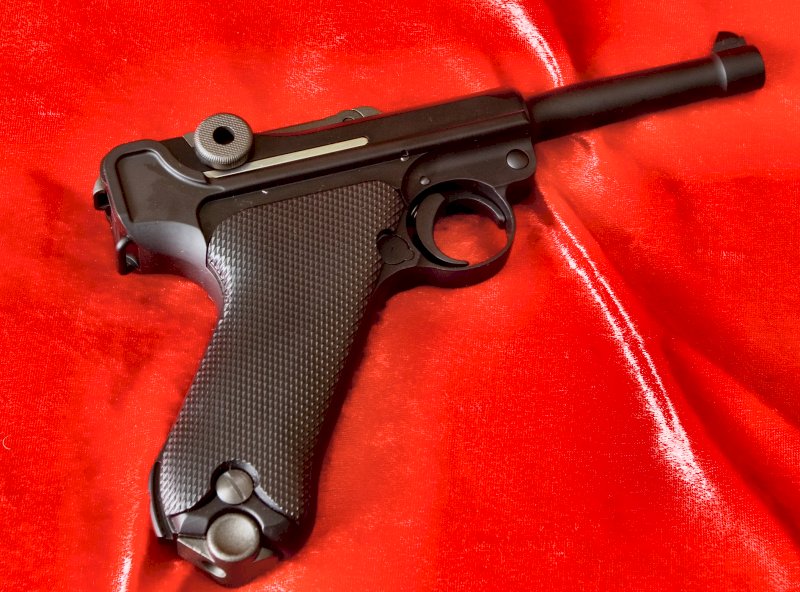
As with Tanaka’s original, the instantly recognisable Luger P08 design is well replicated and WE’s all metal gun is very substantial feeling.
At 855g, with the 175g magazine, it’s heavier than most ABS GBBs, despite the Luger’s slim design – For comparison, my Tanaka Artillery Luger weighs just 740g. It is also very close in weight to a real Luger.
Perhaps more surprisingly, the WE feels tighter than the Tanaka, which has a slight slop to it as you move it around (I suspect this is due partly to a stronger recoil spring in the WE).
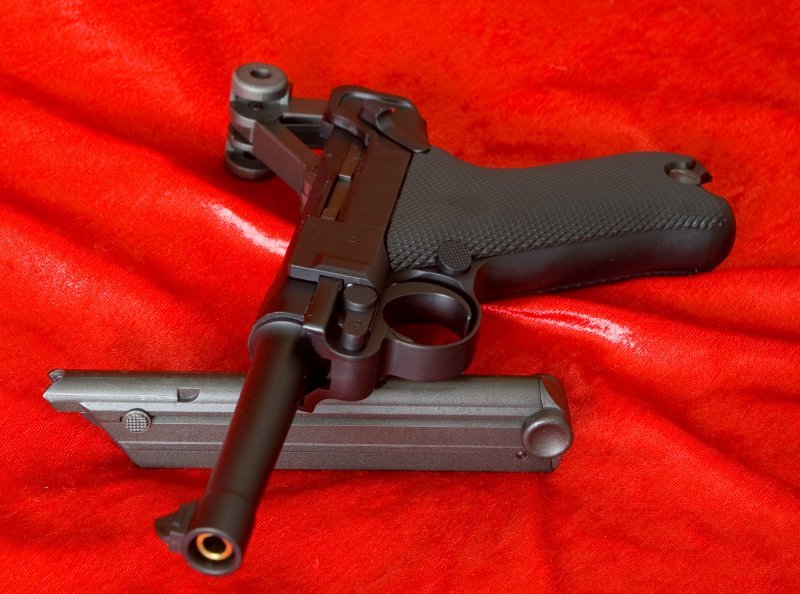
Closer Look
Most of the gun is painted a very even black, but sadly the toggle mechanism and the magazine are that gun-metal grey so beloved of the Taiwanese airsoft manufacturers (WE and HFC in particular) and quite at odds with the black.
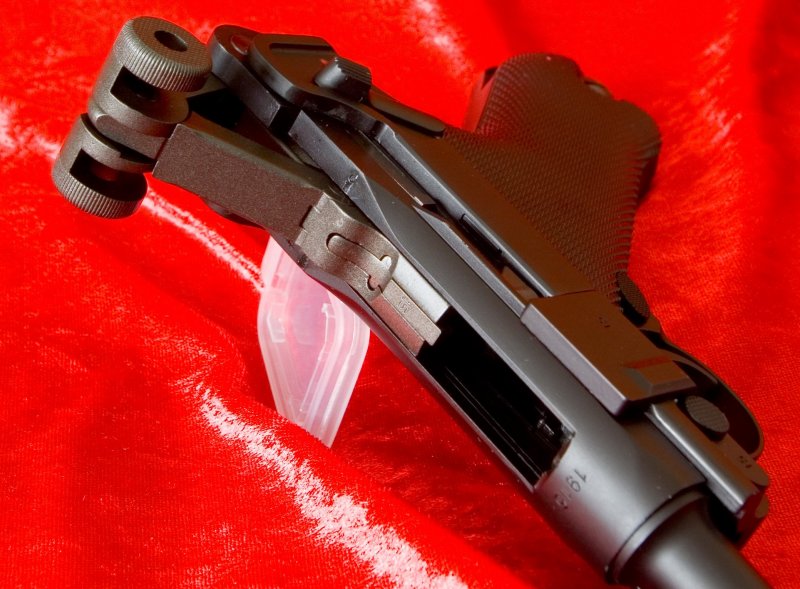
Markings are few with the “15” lifted directly from the Tanaka gun on the toggle, upper receiver, safety, disassembly lever and sideplate, but the DWM markings being absent. Fortunately, though trademarks are less relevant to an older gun like this, so the absence is easier to forgive.

The fit and finish is generally good. The Luger in airsoft or real-steel form is a complex mechanism and doesn’t tolerate poor fit well. I had no issues with the cycling of the WE. In the cold temperatures I mostly tested in (5-10C) it wasn’t keen to lock open on empty, although it did so reliably when dry firing in the warmth of the house.
Aside from the grey finish to the toggle mechanism, the toggle doesn’t appear to be made of as dense a metal as the Tanaka design. I’ve not heard of a spate of broken toggles, so I can only assume it’s strong enough, but you can see this is somewhere WE have compromised on cost. The toggle features the correctly chequered drums and pulls with a reassuring, but smooth action.

The black painted finish is not a thick coating and it wears almost instantly on the faces which rub between upper and lower receiver. Frequent holstering or use would no doubt rub through to the metal below, but this would be easily touched up.
When I picked this example up from Airsoft Armoury, who generously loaned it for review and currently sell it for £100, I also got to handle a silver Luger which appears to be a bare metal polished gun and looked remarkably good, if not terribly authentic and speaks well of the materials used by WE in the Luger.
The magazine looks very like the Tanaka one, taking 15 BBs in a single stack and features a hole part way down the feed spring to load them into, but I could not get the magazine into my Tanaka Luger, so obviously the two designs are not identical.
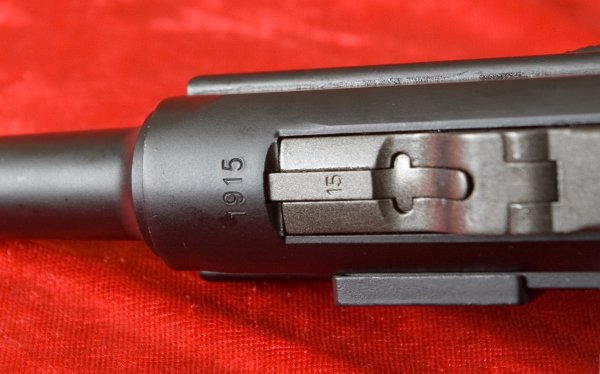
The magazine releases with a simple chequered button on the left side of the frame, just behind the trigger guard.
Unfortunately, I’ve yet to see anyone selling WE Luger magazines separately, so spares will prove a problem as even the dear (but available) Tanaka ones can’t be used.
Something to watch is that, like the Tanaka, the firing pin is exposed when the action is cocked, so never force the magazine in this state as it can break the pin.

The grips have come in for criticism in some reviews, but I didn’t find them too bad. They are extensively chequered, black plastic and lack any of the Tanaka’s struts internally to strengthen them. I didn’t find they flexed when gripped (as some report), but they do sound a little hollow if you tap them, which is a bit disappointing. Wood grips would probably fit and replica Luger grips are available from dealers on the web (WW2 or even WW1 period ones even appear on eBay from time to time).
The back of the grip features a slot for a grip, although these were really intended for use with the long barrelled Navy and Artillery versions.
The whole top half of a Luger recoils when you fire, pushing the toggle mechanism open and this works well on the WE I tested, running smoothly. The barrel and upper receiver are well made as is the frame and, whilst the Tanaka looks more finessed, the WE really doesn’t feel low rent as, perhaps, some of their earlier hi-capa models do.

The trigger is the correct crescent moon style and, although quite heavy at 1000g, the pull is short and very precise, making it feel much better than the weight suggests.
There is a simple safety lever to the rear of the lower receiver (where it kicks up) which features a cast GESICHERT (SAFE) beneath it which is revealed when the safety’s engaged.

The action is the most unique feature of the Luger (only the earlier Borchardt has a similar action and that formed the basis for the Luger mechanism). As the trigger is pulled the BB is fired and the whole upper receiver and barrel move back pushing back on the toggle action, which is forced against a buffer on the lower frame, which causes it to pivot up, extracting the casing on the real thing, and then closes again as the recoil spring (which is inside the barrel) decompresses and forces the upper receiver forward again, chambering the next round.
Shooting Impressions
If you’ve never fired an airsoft Luger you will find the action quite addictive I believe, but the downside is that there’s not much moving weight, even less relatively on the heavy WE compared to the plastic Tanakas, so the kick is limited.
As so little of the gun moves significantly, though, airsoft Lugers are pretty accurate. The Tanaka Artillery I own can do 15mm best 5 of 6 at 5m groupings and even on a cold day, when the power is down and BBs move around more, the 4” delivered a 42mm grouping well grouped in the centre area of the target. I am confident that in warmer temperatures, this would be improved upon. There is an adjustable hop-up, but it does require the gun to be stripped to reach it (not a major task, but not as simple as most modern pistols).

Click on image for bigger version in separate window.
Power is good, too.
As WE copied Tanaka they (licensed or not, I suspect the former, but could be doing them a disservice) also took the Western Arms Magna based gas system, which,even in the 4” version, delivers good power – At just 8C, the Luger was notably more powerful than other GBBs I tested alongside it.
Over 10 shots, the WE Luger averaged 237 fps (using Green gas) indoors (at just 8C).
Experience suggests this would equate to around 289 fps at 20C
| Shot | FPS |
| 1 | 257.2 |
| 2 | 245.2 |
| 3 | 242.6 |
| 4 | 237.3 |
| 5 | 240.8 |
| 6 | 235.2 |
| 7 | 233.3 |
| 8 | 227.1 |
| 9 | 228.0 |
| 10 | 226.6 |
Trigger pull was 1005g (35 Oz), which is a medium to heavy weight pull for a GBB.
Take Down
Thanks to copying Tanaka's design, the WE field strips accurately.
To anyone used to Browning designs (like the 1911) or Berettas, the process is not a little complex, but it is worth bearing in mind that the basic design goes back to the late 19th century!
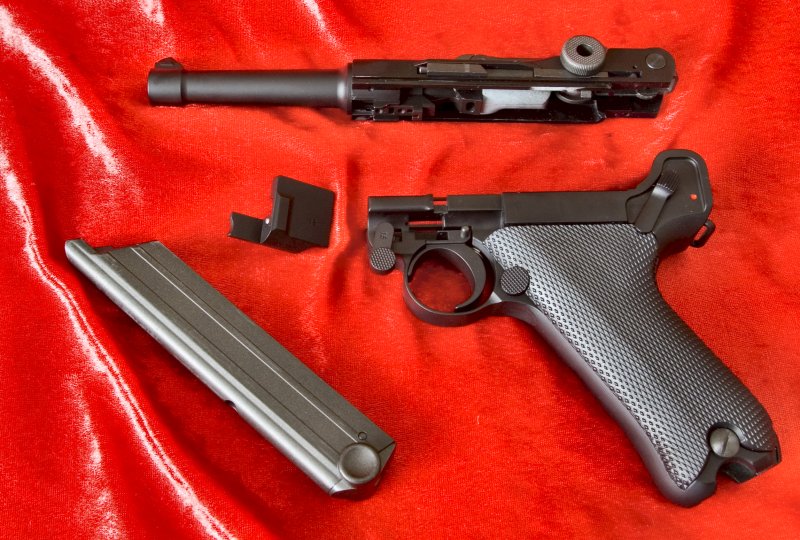
With the magazine removed and the safety engaged, push the barrel back slightly and move the takedown lever on the frame, down from the rear, where there is a chequered 'button' on the lever (this was very tight on my gun, at least initially).
With this down, you can remove the trigger panel (the flat piece above the trigger) and then the whole barrel and receiver can be slide forward off of the frame.
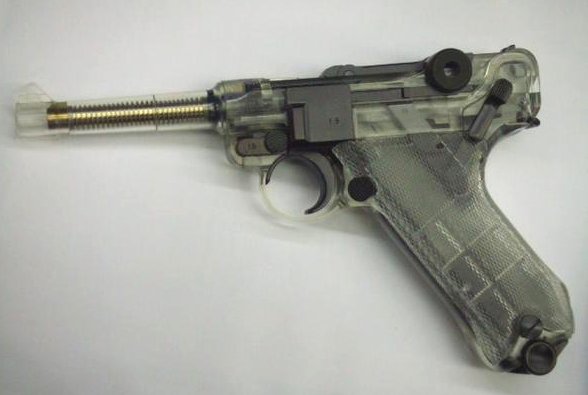
Having done this a couple of times, it is certainly not as easy as with a Browning design automatic, but full marks (to Tanaka!) for taking the trouble to get it right.
This page, from Marstar, explains the process (The subsequent page relates to the real thing ONLY, as the internals are, obviously, different).
Conclusions
Overall, I found it hard not to like the WE P08. It’s not quite a precise feeling as the Tanaka it is based upon, but the solid cold feel is undeniably better and works well and shoots well enough for most purposes.
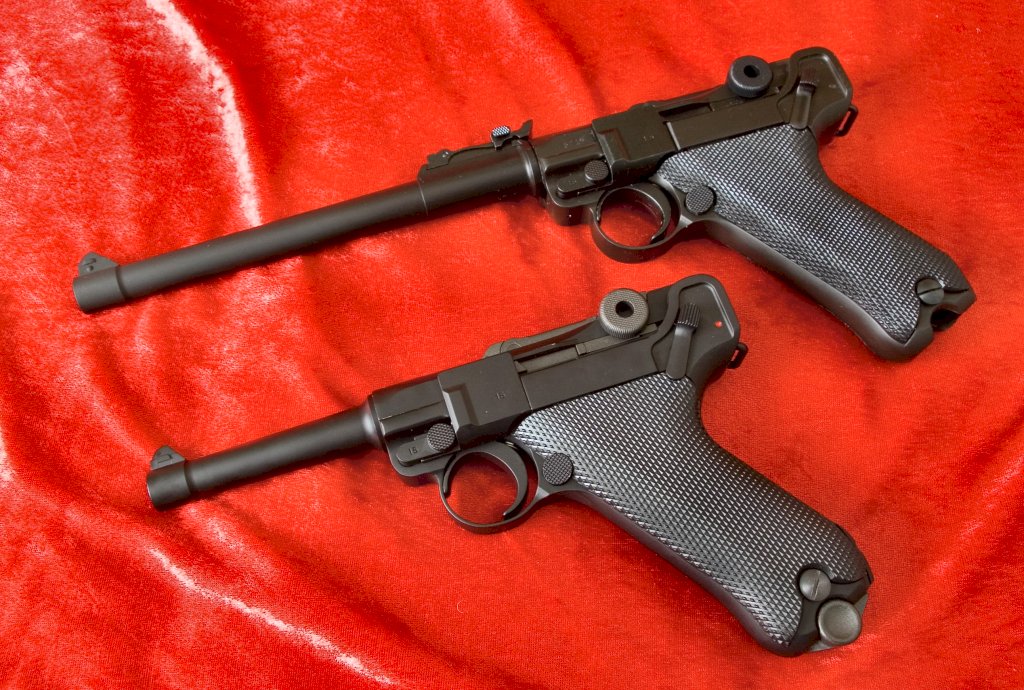
The lack of trademarks is a bit of a shame on a gun of such an old design, but at least there are no silly fake ones and the overall look of the WE Luger is good in black (grey toggle mechanism notwithstanding) or silver.
If your view of WE guns is formed around early hi-capa models, the Luger might be the model to make you think again. The fit and finish of the Luger is night and day from those early WE models and makes the £100 price tag a bit of a bargain.
Weight : 855g (175g Magazine)
Realism : 75%
Quality : 70%
Power : 80%
Accuracy : 70%
Real Steel link at World Guns
Lyn Haywood's review on Arnies Airsoft
For anyone wanting to know more about Lugers, the HLE e-books
provide excellent information at a very reasonable price.
Gun World's extensive Luger section
The Borchardt - The original semi-auto
handgun, from which the Luger is derived.
Marstar in Canada - Sell reproduction leather holsters and other parts.
Back to the Homepage